Driver’s view: R&R Mills’ 12.2m Claas Convio Flex combine header
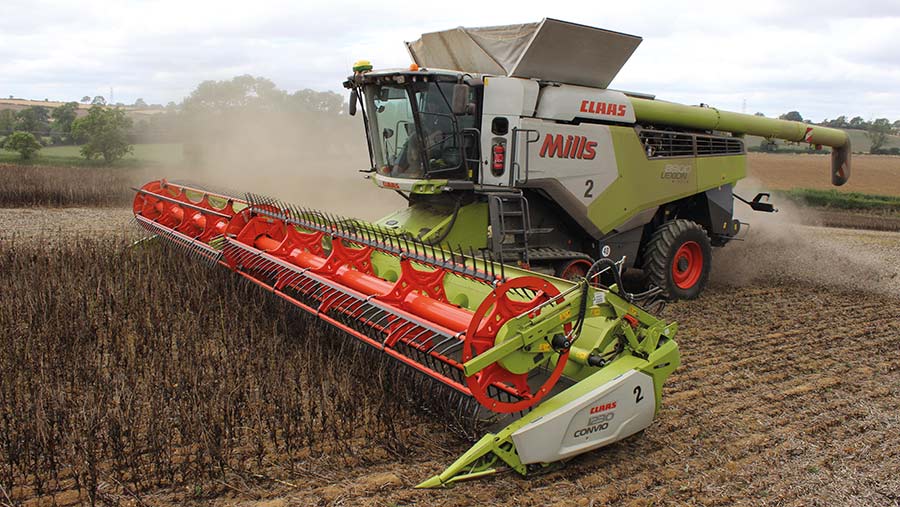 © Peter Hill
© Peter Hill They were once the preserve of big, open grain fields in Australia, Canada, and the United States, but ultra-wide headers have become the new must-have on the latest high-output combines. We’ve asked growers what benefits they get from these increasingly sophisticated attachments.
Matt Houldcroft, R&R Mills, Empingham, Rutland
- Combine Claas Lexion 8900
- Header 12.2m (40ft) Claas Convio Flex – rigid frame with a flexible knife
The ability to tackle a wide range of crops – including soya and millet – proved a valuable capability for contractor R&R Mills last year as the business got to grips with its first experience of a draper header.
Matt Houldcroft, farm manager, recalls: “After we had completed the bulk of our grain and oilseed crop harvest, we picked up about 160ha of soya, standing only a few inches tall, and 180ha of millet, as growers introduced new crops.
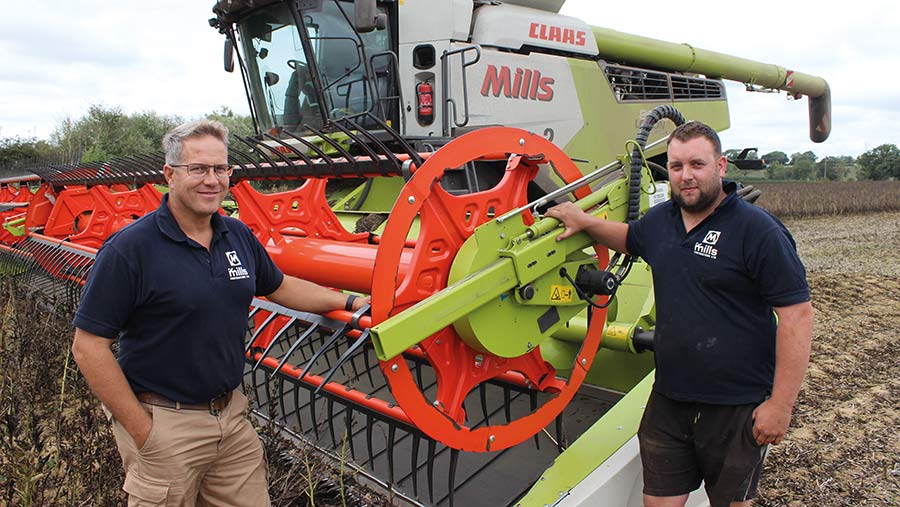
R&R Mills farm manager Matt Houldcroft (left) with Nathan Parsons, one of the firm’s combine operators © Peter Hill
“It was additional work that we wouldn’t have got without the Convio Flex header and its ability to run very tight to the surface and feed in whatever you cut. It has also made cutting crops such as beans a lot easier and quicker, running at 10kph without worrying too much about bulldozing.”
From the company’s home base at Empingham, near Oakham in Rutland, the Mills operation typically tackles at least 2,630ha of winter wheat, winter and spring barley, oilseed rape and linseed.
This comes mainly from stubble-to-stubble farm contracts, but also regular and ad-hoc contract harvesting that varies in volume depending on harvest conditions and local cropping.
Having previously operated Claas Lexion 770 and 780 combines with 10.7m and 12.2m Vario headers, plans to swap out the 770 brought the opportunity to consider an alternative to this well-regarded adjustable-knife auger header.
“We never had any real issues or problems with the Vario headers, although the auger would wrap in dampish crops until the sun came out and dried things off,” says Mr Houldcroft.
“You could alter the strippers and so on to solve the issue but, ultimately, it highlighted that the header was the limiting factor on the combines’ performance.”
See also: Honey Bee swather expands cropping options for Hants grower
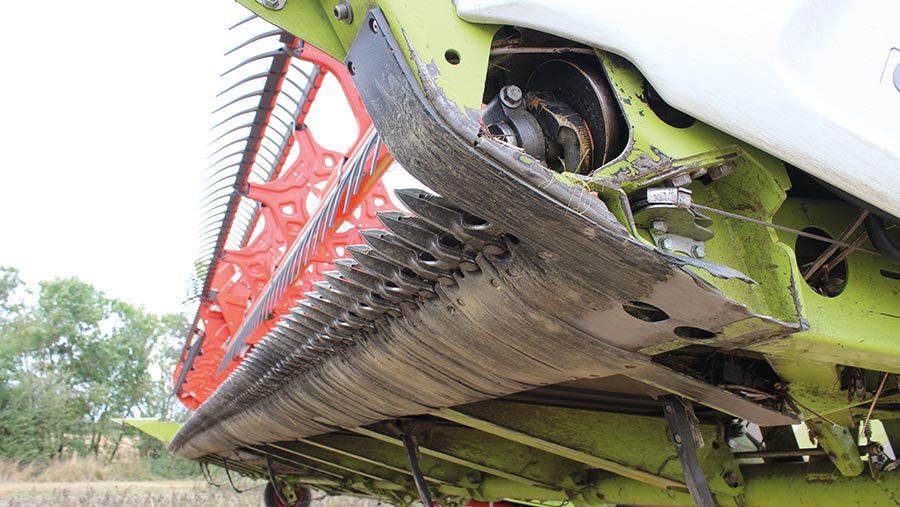
© Peter Hill
Successful demo
Growing interest in the MacDon draper header led to an example being brought to the farm for a challenging tryout in a laid crop of wet winter barley.
“It was an absolute revelation; the header picked up and fed in everything as it shaved the flat crop off the surface, and did it so well that it was the combine that became the limiting factor,” Mr Houldcroft recalls.
“We also had a John Deere combine on demonstration with a draper header that was just as good, dropping the crop onto the belts and feeding it in nicely. That reinforced our view that the concept of a draper header worked well and had a lot to offer our operations.”
A third option came into the frame when the then-new Convio Flex header was seen working cleanly in a flat crop of barley alongside a Vario that needed to stop and clear its throat every so often.
It swung the decision to order a Lexion 8900 Terra Trac with Convio Flex header to increase seasonal capacity for harvest 2021.
“The MacDon was tempting but, in the end, we opted for an all-Claas package with a six-year extended warranty, not least because we wanted to keep things straightforward should we have any problems,” Mr Houldcroft explains.
“One manufacturer, one dealer, one engineer and one parts department, so only one source of responsibility. As contractors, getting problems sorted quickly and efficiently to keep our machinery operating is very high on our list of priorities.”
Operating a 12m/24m/36m controlled-traffic system across its contract-farmed properties meant limiting the new combine’s header to a 12.2m example and accepting it would be working fast to make the most of its capacity potential.
“The Cemos Auto system, complete with grain quality analysis which gives automatic adjustments to combine settings, was included to ensure we would get optimum performance at relatively high forward speeds.”
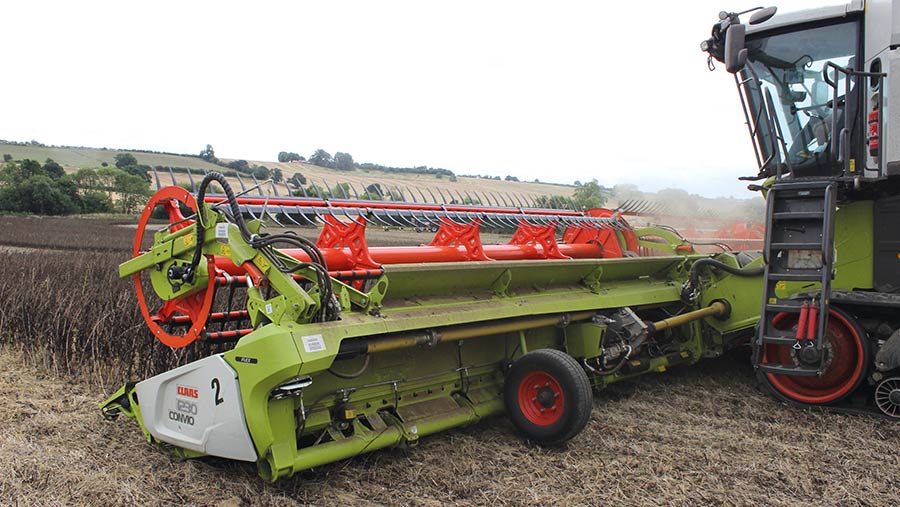
© Peter Hill
Cutting low
With 75% of the straw sold, it’s important to cut grain crops low. And that is certainly possible with the new header, on which the knife can be kept rigid or allowed to flex to a varying degree, with adjustable hydraulic pressure pushing it into dips and hollows.
“With limited opportunity for guidance because of Covid-19 restrictions that year, we ended up running the knife in flex mode throughout and, as a result, wore out a few of the plastic skids underneath,” Mr Houldcroft says.
“We’re still learning as the operators gain experience, but this year the knife was kept rigid for all the winter wheat, just flicking to flex with some light pressure for laid areas, and leaving a 10-13cm stubble to keep the header off our abrasive limestone brash soils.
“It’s pretty much the same in winter and spring barley unless there’s a lot of brackling, in which case flex mode with light pressure is the setup used. This gives increased pressure for an added ground-hugging effect where the crop is flat to the floor or to follow surface undulations, where necessary.”
In oilseed rape, the header is kept off the deck with the knife rigid, of course, but with the header tilted back on the fore/aft adjustment ram on the elevator housing. This minimises draper belt angle and maximises seed retention.
The opposite is the case with linseed, bales of which provide a weatherproof base and cap for outdoor energy straw stacks. For this crop, the knife is encouraged to flex across the surface to leave as little fibrous stubble as possible.
At full downward flex on a significantly undulating surface the reel becomes less effective at drawing crop in, says Mr Houldcroft. Equally, flexing significantly upwards can have the knife nibbling at the reel, as a few shorter-than-original plastic tines illustrate.
“Potential losses from the header is also something we’ve become aware of, so we now use our Bushel Plus magnetic tray drop system to monitor any seed losses from around the central feed belt, as well as for losses coming off the back of the combine,” he adds.
It is all valuable experience for when a second Lexion 8900 and Convio Flex header combination arrives for harvest 2023.
The options
The Convio Flex, available in 7.7m, 9.22m, 10.7m, 12.2m and 13.8m widths, has a flexible cutterbar supported on arms with Active Float hydro-pneumatic suspension providing 225mm of vertical movement – 90mm upwards and 135mm downwards.
Operators can switch between rigid and flexible on the move to handle patches of laid crop.
In “Manual Flex” mode, the knife bar suspension uses information from underbed sensors to respond to ground contours without exerting pressure, and in “Auto Flex” mode, the system automatically determines the best position for crop flow while adapting to ground contours with the lowest possible cutting height.
Other rigid-frame draper headers with a flexible knife include the 9.2m Geringhoff Flex and John Deere RDF HydraFlex.
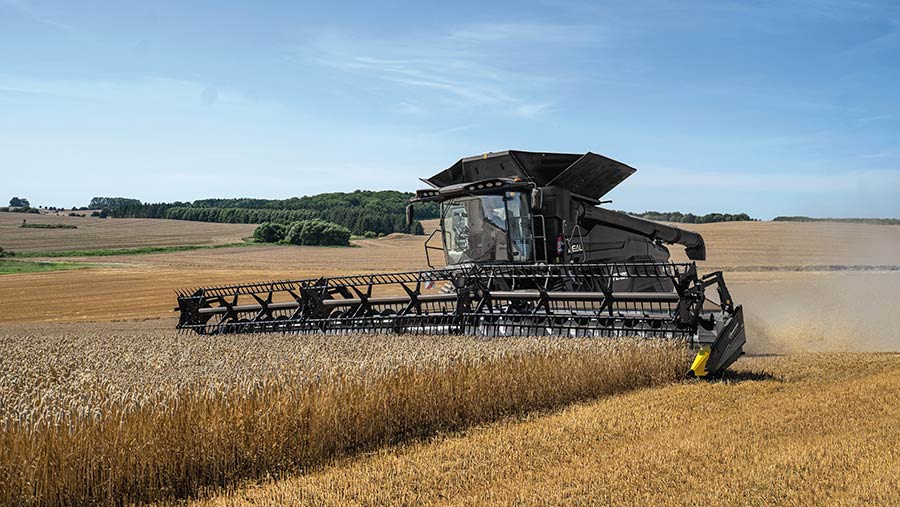
Geringhoff TruFlex Razor Air © Fendt

